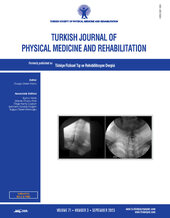Exercise and two different kinesio taping techniques in patients with sacroiliac joint dysfunction: A randomized controlled trial
2 Department of Physical Medicine and Rehabilitation, Ufuk University Faculty of Medicine, Ankara, Türkiye
3 Department of Biostatistics and Informatics, Ankara University Faculty of Medicine, Ankara, Türkiye
4 Department of Physical Medicine and Rehabilitation, Güven Hospital, Ankara, Türkiye DOI : 10.5606/tftrd.2024.15545 Objectives: The study aimed to compare the effectiveness of home exercise and two different kinesio taping (KT) techniques applied in addition to home exercise in patients with sacroiliac joint dysfunction (SIJD).
Patients and methods: This three-arm, randomized controlled trial was conducted with 99 patients (84 females, 15 males; mean age: 27.1±10.7 years; range, 18 to 64 years) with SIJD between December 1, 2016, and July 20, 2024. The patients were randomized into one of the three groups: home exercise group (n=33), ligament correction KT group (n=33), and lymphatic correction KT group (n=33). The KT groups were also given a home exercise program. The pain intensity and patient global assessments were conducted using a 10-cm Visual Analog Scale. The disability level was assessed using the Oswestry Disability Index. Assessments were performed at baseline (T1), four weeks (T2), and eight weeks (T3).
Results: In the home exercise group, there was no significant change in pain levels at rest over time. Significant improvements were found in other parameters in all groups. The pain level at rest was significantly reduced at the T1-T2 interval in the lymphatic correction KT group compared to the home exercise group. At the T1-T3 interval, both KT groups showed a statistically significant reduction in pain at rest compared to the home exercise group. Both KT groups showed a statistically significant improvement in disability compared to the home exercise group.
Conclusion: In the treatment of SIJD, both KT techniques added to the home exercise program were more effective on pain, patient global assessment, and disability than the home exercise program alone.
Keywords : Exercise, kinesio taping, pain, sacroiliac joint

















